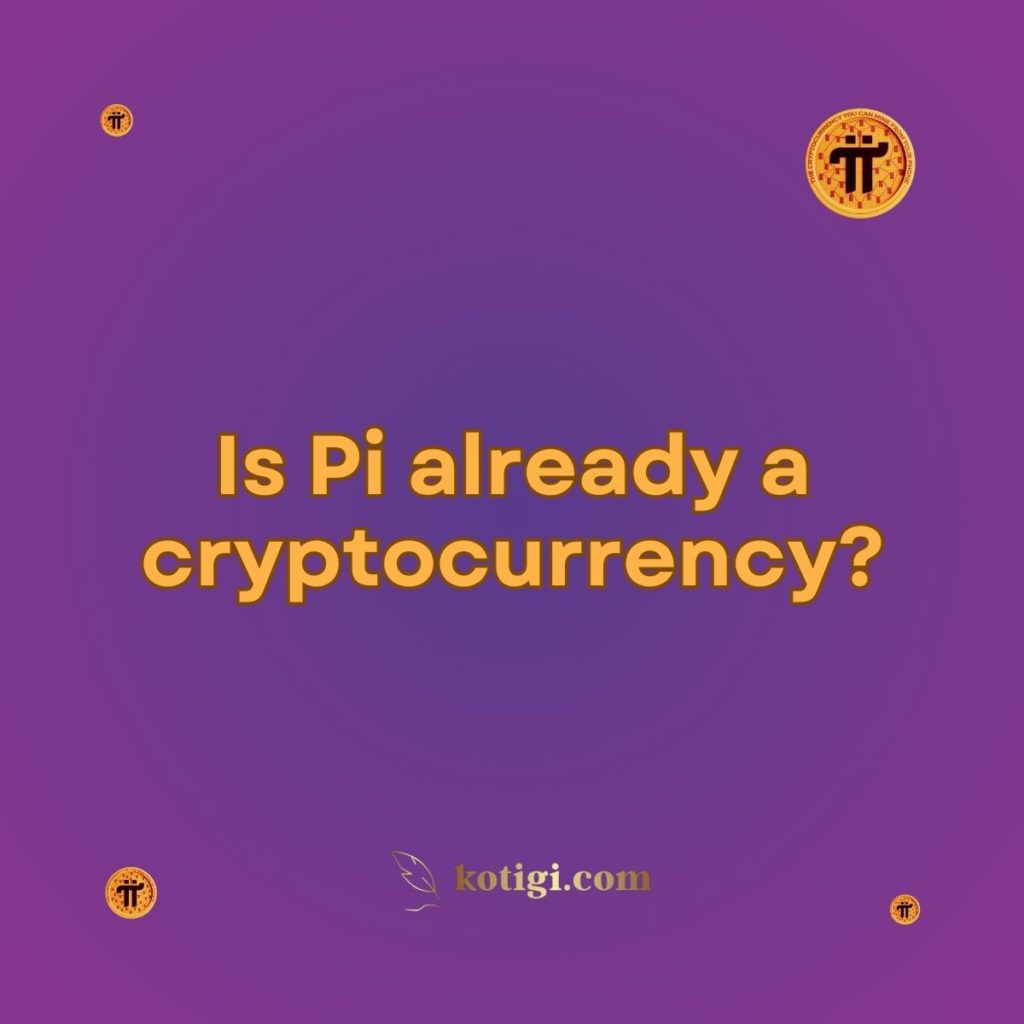
With over 50 million users worldwide, Pi Network has quickly become a topic of conversation in the crypto space. While many are actively mining Pi coins on their smartphones, there’s a lingering question: Is Pi already a cryptocurrency? To answer this, we must first understand what defines a cryptocurrency and whether Pi meets the criteria. This post dives deep into the key features of cryptocurrencies and examines where Pi Network currently stands in its journey.
What Makes a Cryptocurrency?
Before we determine whether Pi qualifies as a cryptocurrency, let’s explore the fundamental elements that characterize cryptocurrencies.
1. Decentralization
A defining feature of any true cryptocurrency is decentralization. Unlike traditional currencies, which are controlled by central banks or governments, cryptocurrencies rely on decentralized networks. This means that no single entity has overarching control of the system. Bitcoin and Ethereum are prime examples of this, as their decentralized nature is maintained by numerous nodes spread across the globe.
2. Blockchain Technology
Blockchain technology serves as the backbone of most cryptocurrencies. It’s a transparent, immutable ledger where transactions are recorded in blocks that are linked together. This ensures that all transactions are secure and cannot be tampered with, creating trust in the network.
3. Peer-to-Peer Transactions
Cryptocurrencies allow peer-to-peer (P2P) transactions, meaning that individuals can send and receive payments directly without relying on intermediaries like banks. This reduces costs, speeds up transactions, and opens up access to financial services for people in underbanked regions.
4. Cryptographic Security
To safeguard the integrity of a cryptocurrency, cryptography is employed to secure transactions and manage the creation of new units. Cryptographic protocols ensure that the system remains secure, preventing unauthorized parties from altering transaction data.
Is Pi Network Currently a Cryptocurrency?
Now that we’ve outlined the core characteristics of cryptocurrencies, let’s examine whether Pi Network currently fits the bill.
1. Pi’s Use of Blockchain Technology (Work in Progress)
As of now, Pi Network is operating on a Testnet, which serves as a testing environment. This is not yet the fully decentralized Mainnet that Pi aims to transition to. While Pi’s goal is to function on a decentralized blockchain, similar to established cryptocurrencies like Bitcoin and Ethereum, it’s not there yet.
In short, Pi is not fully operating on a blockchain—at least not the kind that meets the standards of widely recognized cryptocurrencies. The move to the Mainnet will mark Pi’s adoption of blockchain technology and its transition to a decentralized currency.
2. Pi’s Consensus Mechanism (Innovative Approach)
Unlike Bitcoin’s energy-intensive Proof of Work (PoW) or Ethereum’s Proof of Stake (PoS), Pi Network uses the Stellar Consensus Protocol (SCP). This innovative consensus algorithm allows users to validate transactions by building a network of trust rather than solving complex mathematical problems.
This makes Pi more energy-efficient and eco-friendly. However, it is still a work in progress as the Testnet evolves. Once Pi goes live on its Mainnet, the SCP will operate at full capacity, providing a decentralized framework that powers Pi’s blockchain.
3. Market Value of Pi (Not Yet Tradable)
One of the critical aspects of a cryptocurrency is its ability to be traded for value. Currently, Pi coins cannot be traded on any major exchanges, and thus, they hold no market value.
The Pi Network team has stated that the coin will be listed on exchanges after the Mainnet launch. Until Pi becomes tradable and holds monetary value, it cannot be classified as a fully operational cryptocurrency in the traditional sense. Essentially, Pi is still a digital asset with potential but no liquid value yet.
4. Does Pi Enable Peer-to-Peer Transactions? (Not Yet)
At this stage, Pi coins cannot be used for everyday transactions. The Pi Network team is working toward creating an ecosystem where Pi can be exchanged for goods, services, and even other cryptocurrencies. However, this feature will only materialize once the Mainnet goes live. For now, users are primarily collecting and mining Pi coins in anticipation of their future use.
The Road Ahead for Pi: A Cryptocurrency in the Making?
1. Transition to the Mainnet
The transition from Testnet to Mainnet is the next significant step in Pi Network’s development. The Mainnet will bring Pi into the realm of fully decentralized cryptocurrencies, at which point Pi coins can potentially be listed on exchanges and used for real-world transactions. Only after this transition will Pi fully embody the characteristics of a cryptocurrency.
2. Pi’s Ecosystem Potential
Pi Network’s ecosystem is one of its most ambitious goals. The team envisions a marketplace where users can buy goods, access services, and engage with decentralized applications (dApps) using Pi coins. For Pi to succeed, it will need to build a robust and thriving ecosystem that provides real utility for its users.
3. Challenges Along the Way
Despite its growing community and ambitious goals, Pi Network still faces several hurdles. The project must navigate its transition to the Mainnet smoothly, build a secure and decentralized blockchain, and establish a real-world use case for Pi coins. Additionally, it will need to gain legitimacy in the broader cryptocurrency market, which is already highly competitive.
Comparison with Established Cryptocurrencies
1. Pi vs. Bitcoin
Bitcoin is the gold standard for cryptocurrencies. It’s decentralized, secure, and widely accepted. Pi, on the other hand, is still in its infancy. While Pi’s approach to mining is more eco-friendly, it lacks the decentralized nature and established market value that Bitcoin offers. For now, Pi’s future hinges on its Mainnet launch and the subsequent adoption of its blockchain.
2. Pi vs. Ethereum
Ethereum stands out due to its smart contract functionality and thriving dApp ecosystem. Pi, however, aims to build its own ecosystem centered on mobile mining and social trust. While both projects are ambitious, Ethereum is far ahead in terms of development, adoption, and market value. Pi’s potential lies in its accessibility and community-driven approach, but it remains to be seen how it will compete with Ethereum’s established infrastructure.
Conclusion
Pi Network is still in its formative stages, aiming to become a decentralized cryptocurrency. While it offers an innovative approach to mobile mining and uses an eco-friendly consensus algorithm, Pi has yet to make the leap to a fully operational blockchain. Its current lack of market value and real-world utility means that Pi cannot yet be classified as a complete cryptocurrency. However, with its growing user base and ambitious plans, Pi has the potential to become a major player in the crypto space—once it crosses the finish line to Mainnet.
Is Pi already a cryptocurrency?
Not quite yet. While Pi Network is moving towards becoming a full-fledged cryptocurrency, it is still in its development phase. The coin operates on a Testnet, meaning it has no market value or full blockchain functionality. Once Pi transitions to its Mainnet and becomes tradable, it will meet the criteria of a decentralized cryptocurrency.
Key Takeaways
- The transition to Mainnet will be the defining moment when Pi can officially be considered a cryptocurrency, with the potential for real-world utility and market value.
- Pi is not yet a fully operational cryptocurrency but is in the process of becoming one through its Mainnet launch.
- Pi coins have no current market value, and they cannot be traded on exchanges until the Mainnet transition.
- Pi uses the Stellar Consensus Protocol (SCP) for its mining process, which is more energy-efficient than traditional mining methods like Bitcoin’s Proof of Work.
- Pi’s success hinges on building a decentralized ecosystem where the coin can be used for real-world transactions.





